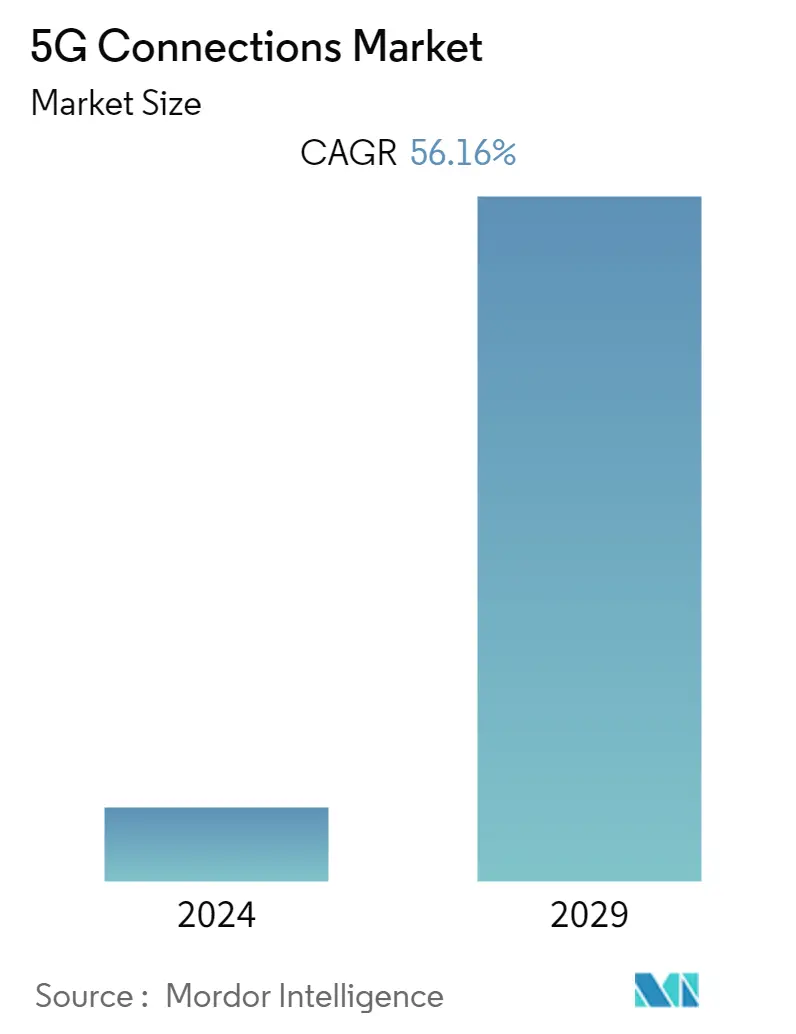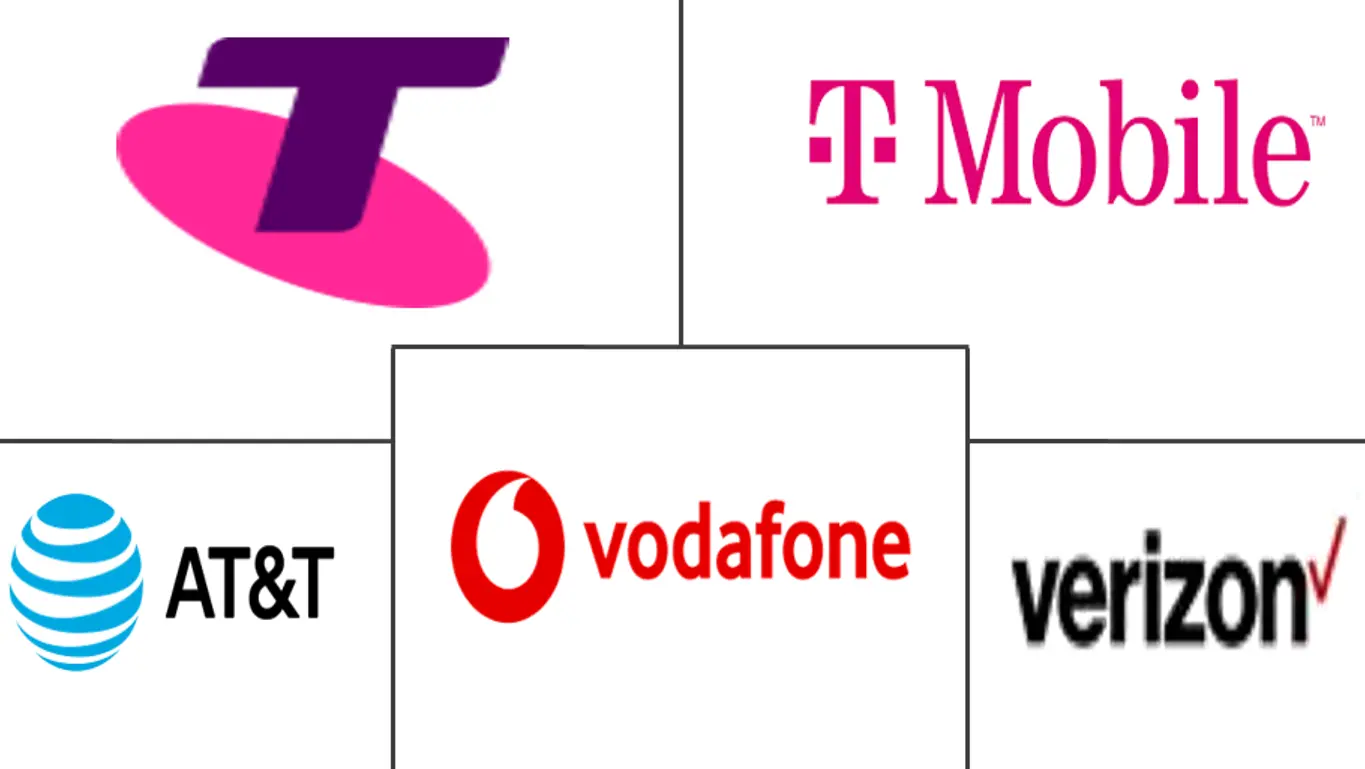Market Size of 5G Connections Industry

| Study Period | 2019 - 2029 |
| Base Year For Estimation | 2023 |
| CAGR | 56.16 % |
| Fastest Growing Market | Asia Pacific |
| Largest Market | North America |
| Market Concentration | Low |
Major Players
*Disclaimer: Major Players sorted in no particular order |
5G Connections Market Analysis
The 5G Connections Market size is estimated at USD 106.64 billion in 2023, and is expected to reach USD 990.33 billion by 2028, growing at a CAGR of 56.16% during the forecast period (2023-2028).
According to Ericsson data, with the addition of 136 million 5G subscribers in the last quarter of 2022, Global 5G subscriptions reached the one billion milestone. 5G is expanding faster than its predecessors in the mobile generation. Ericsson further claims, by 2027, about three-quarters of the world's population will be able to access 5G.
- Robust infrastructure like fiberizing the towers will accelerate the 5G expansion across the world. Fiber-rich network infrastructure can support features like increased speeds with lower attenuation, immunity to electromagnetic interference, small size, and virtually unlimited bandwidth potential. Without fiber optics, 5G will have limited performance, so Telcos are investing in laying these fibers for further expansion.AT&T partnered with the private equity company BlackRock Alternatives for a project called Gigapower to provide a wholesale fiber network across the U.S. Initially, the fiber network will be installed in 1.5 million customer locations.
- The adoption of IoT in various businesses will drive 5G. Emerging smart city projects or Intelligent Transport Systems (ITS) are cases that require the amalgamation of IoT and 5G. 5G is being used with autonomous vehicles in mining to provide safety measures for workers. The low latency of 5G helps in making quick real-time decisions. This means cameras or sensors can be mounted on vehicles to notify workers of potential collisions and accidents while they work in mines.
- Increasing demand for cloud data or applications that use massive amounts of data to provide actionable insights will also require 5G. The high speeds and low latency of 5G can stream endless waves of data to a central cloud server, where IoT devices on the network edge can make efficient decisions. For instance, streaming patient health data from a moving ambulance to a hospital will be easy with 5G services.
- The Covid-19 pandemic was the most important time for 5G as a revolutionary technology. Many applications were tested based on the integration of 5G in combination with other digital technologies. During COVID-19, 5G was the most effective tool for supporting medical diagnosis and treatment; the trend is still present today. For instance, The healthcare sector most benefited from using 5G since the network's high capacity and low latency enable the transmission of high-definition footage for processing and analytics. This tool will assist in identifying patients who are acting differently than usual, have experienced an incident like a fall, or are becoming a danger to themselves or others.
- Implementation of 5G technology involves high costs. Utilizing mm-Wave frequencies, rolling out large-scale fiber optic cables, and lacking skilled labor involves high cost. Every 5G technology implementation step are challenging for most Communication Service Providers (CSPs).
5G Connections Industry Segmentation
The fifth-generation cellular technology, or 5G, is utilized for mobile communications. Compared to earlier generations, 5G networks provide lower latency and faster speed. According to trial runs, 5G will offer response times as low as one millisecond. Widespread deployment of 5G technology will support effective working from any remote location.5G's enhanced connection stability enables IoT in areas without Wi-Fi coverage. Automobile companies plan to integrate 5G antennas in their vehicles called connected cars. Self-driving cars will be the next era of 5G or IoT integration in automobiles.
The 5G Connections Market is segmented by Connection Type (Mobile Broadband, Fixed Wireless Access, M2M and IoT, and Mission-critical) and Geography. The market sizes and forecasts are provided in terms of value (USD) for all the above segments.
| Connection Type | |
| Mobile Broadband | |
| Fixed Wireless Access | |
| M2M and IoT | |
| Mission-critical |
| By Geography | ||||||
| ||||||
| ||||||
| ||||||
| Rest of the World |
5G Connections Market Size Summary
The 5G Connections Market is experiencing rapid expansion, driven by the need for enhanced connectivity and the integration of Internet of Things (IoT) applications. The market is characterized by significant investments in infrastructure, such as fiber-optic networks, which are crucial for supporting the high speeds and low latency that 5G offers. This technology is revolutionizing various sectors, including smart cities, autonomous vehicles, and healthcare, by enabling real-time data transmission and decision-making. The COVID-19 pandemic accelerated the adoption of 5G, highlighting its potential in critical applications like medical diagnostics and treatment. Despite the high costs associated with 5G implementation, such as the deployment of mm-Wave frequencies and fiber optic cables, the demand for cloud data and applications is driving its growth.
In North America, the 5G market is poised for substantial growth, with strong spectrum availability and strategic partnerships enhancing network quality and coverage. Major players like AT&T, Verizon, and T-Mobile are leading the charge, focusing on innovation and expansion to maintain a competitive edge. Collaborations, such as AT&T's partnership with Microsoft for private edge networks and Verizon's smart manufacturing initiatives, are indicative of the industry's dynamic nature. The market's competitive landscape is further shaped by developments in automotive and smart city technologies, with companies like Hyundai Mobis and Bosch leveraging 5G to enhance vehicle connectivity and urban infrastructure. As 5G continues to evolve, it is set to transform industries by enabling seamless connectivity and operational efficiencies.
5G Connections Market Size - Table of Contents
-
1. MARKET INSIGHTS
-
1.1 Market Overview
-
1.2 Industry Attractiveness - Porter's Five Forces Analysis
-
1.2.1 Bargaining Power of Suppliers
-
1.2.2 Bargaining Power of Buyers/Consumers
-
1.2.3 Threat of New Entrants
-
1.2.4 Threat of Substitutes
-
1.2.5 Intensity of Competitive Rivalry
-
-
1.3 Market Drivers
-
1.3.1 Increase in Demand for Wireless Broadband Services Needing Faster, Higher-Capacity Networks
-
-
1.4 Market Challenges
-
1.4.1 High Infrastructure Setup Cost During the Initial Rollout Phase and Relatively Less Range of Coverage
-
-
-
2. MARKET SEGMENTATION
-
2.1 Connection Type
-
2.1.1 Mobile Broadband
-
2.1.2 Fixed Wireless Access
-
2.1.3 M2M and IoT
-
2.1.4 Mission-critical
-
-
2.2 By Geography
-
2.2.1 North America
-
2.2.1.1 United States
-
2.2.1.2 Canada
-
-
2.2.2 Europe
-
2.2.2.1 Germany
-
2.2.2.2 France
-
2.2.2.3 United Kingdom
-
2.2.2.4 Rest of Europe
-
-
2.2.3 Asia Pacific
-
2.2.3.1 India
-
2.2.3.2 China
-
2.2.3.3 Japan
-
2.2.3.4 Rest of Asia Pacific
-
-
2.2.4 Rest of the World
-
-
5G Connections Market Size FAQs
What is the current 5G Connections Market size?
The 5G Connections Market is projected to register a CAGR of 56.16% during the forecast period (2024-2029)
Who are the key players in 5G Connections Market?
AT&T Inc., Verizon Communications Inc., Vodafone Group Plc, T-Mobile US Inc. (Sprint Corporation) and Telstra Corporation Ltd are the major companies operating in the 5G Connections Market.

